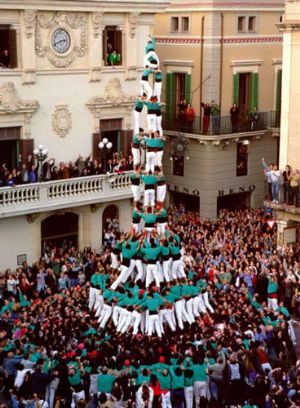 The Castellers de Vilafranca
is a cultural and sporting association whose main objective is to build
castells (human towers). It has the status of a public-interest association.
The group was founded in 1948 in response to the increased interest in
human tower building in Vilafranca del Penedès, a Catalan tradition
that has evolved since the 18th Century Ball de Valencians, a dance from
Valencia. The Castellers de Vilafranca
is a cultural and sporting association whose main objective is to build
castells (human towers). It has the status of a public-interest association.
The group was founded in 1948 in response to the increased interest in
human tower building in Vilafranca del Penedès, a Catalan tradition
that has evolved since the 18th Century Ball de Valencians, a dance from
Valencia.
Nowadays, the Castellers
de Vilafranca have about 400 active human tower building members of all
ages, with no discrimination on the grounds of race, religion, sex or social
status. They share the common goal of building human towers, democratic
values, cooperation and team work, a constant desire to surpass themselves,
and a will to maintain a lead over a select and competitive group of rival
human tower associations.
The group’s headquarters
is Cal Figarot, Casa Via Raventós, a house located in downtown Vilafranca
del Penedès and specially adapted for human tower building activity
(for example, high, indoor ceilings for winter use and an open-air courtyard
for spring, summer and fall).
The group is one of the most
important organizations in Vilafranca del Penedès and has represented
Catalan culture abroad numerous times. The association has more than five
hundred official supporters, and has the support of several public and
private institutions. In addition to hosting and participating in human
tower exhibitions, it also organizes other cultural activities, such as
small-scale concerts, a poetry contest, a massive bicycle event, a dominoes
tournament, food events and a human tower school for kids. The Castellers
de Vilafranca’s efforts to preserve and promote popular Catalan culture
have been recognized by the town of Vilafranca del Penedès, which
awarded the group with the Medalla de la Vila (the town medal), and by
the Generalitat de Catalunya (the Catalan Government) with the Creu de
Sant Jordi (Cross of Saint George).
History
The Castellers de Vilafranca
cultural association was founded in September 1948 by Oriol Rossell, who
became the first cap de colla (Leader/Technical Manager of the group).
The group successfully started with seven-level towers, and also forged
close relationships with casteller groups in other towns. The first caps
de colla were Oriol Rossell (1948-1952) and Ramon Sala (1953-1955). The
group originally wore rose-coloured shirts, and subsequently, red ones.
In 1956, the group became almost inactive due to internal disagreements
and disputes. In 1957, it reorganized and elected to wear green shirts,
which is still the distinctive colour used by the group today.
From 1957
to 1968, seven-level towers were the norm, and the cinc de set was the
highest tower achieved. From 1969 to 1974, the group improved considerably,
building the first towers in the eight-level category: the torre de Set,
quatre de vuit, tres de vuit, pilar de sis, and the torre de vuit amb folre.
In 1972, the group won the Concurs de castells de Tarragona, the Human
Towers Competition held biennially in Tarragona city in the south of Catalonia.
During those years, the caps de colla were Josep Pedrol (1957-1959), Carles
Domènech (1960-1961), Joan Bolet (1962-1963), Gabi Martínez
(1964-1969), Lluís Giménez (1970-1973) and Gabi Martínez,
again (1974).
In 1975, the group went through
major internal restructuring, shifting from the very personal and almost-exclusive
leadership of the cap de colla to management of the technical side of tower-building
by a consensual team. 1981 brought with it more internal changes, and it
was decided that team members would no longer be individually paid. This
provoked a division in the group. From 1975 to 1982, eight-level towers
were performed frequently but with difficulties. In 1983 and 1984, the
group regained its strength in this category and, in 1985, it built the
first cinc de vuit. This landmark achievement proved merely to be a milestone
on the way to even more impressive nine-level towers. In 1987, the first
tres and quatre de nou amb folre (carregat) arrived, and in 1989 the first
completely successful tres de nou amb folre (descarregat) was achieved.
Similar success came in 1990 with the first quatre de nou amb folre (descarregat).
The cap de colla between 1975 and 1994 was Carles Domènech.
Between 1995 and 2004, the
group enjoyed its most successful years to date. During this period, the
highest and most difficult towers were achieved: descarregats (completely
and successfully dismantled) the torre de nou amb folre i manilles, pilar
de set amb folre, pilar de vuit amb folre i manilles (the first one in
the 20th Century), quatre de vuit amb l’agulla (the first one in the 20th
Century), quatre de nou amb folre i l’agulla (the first one in human tower
history), cinc de nou amb folre, and tres and quatre de nou amb folre built
simultaneously (the first - and only - time in human tower history). There
were other successes, too. As for towers that were “only” carregats (reached
the top but collapsed afterwards): the torre de vuit (the first one in
20th Century); quatre de nou, and the tres de deu amb folre i manilles
(the first one in human towers history). The group also won the Tarragona
Human Towers Competition in 1996, 1998, 2002, 2004 and 2006. In 2005 Castellers
de Vilafranca achieved the torre de nou amb folre, which is considered
the most difficult tower ever done by any group to date.
Francesc Moreno "Melilla"
was the cap de colla between 1995 and 2003, and Lluís Esclassans
from 2004 to 2007. David Miret was elected the new cap de colla in December
2007.
Courtesy
Wikipedia |

